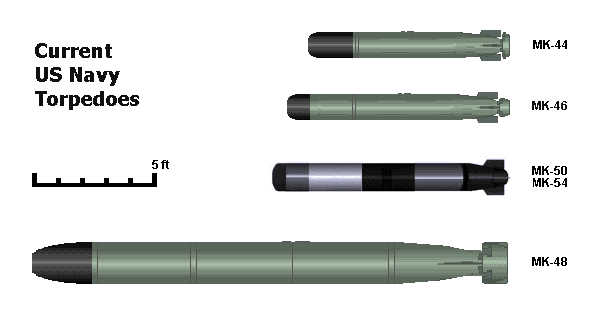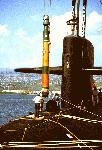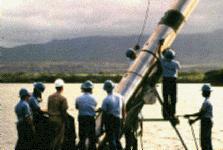










The MK-48 is designed to combat fast, deep-diving nuclear submarines and high performance surface ships. It is carried by all Navy submarines. The improved version, MK-48 ADCAP, is carried by attack submarines, the Ohio class ballistic missile submarines and will be carried by the Seawolf class attack submarines. The MK-48 replaced both the MK-37 and MK-14 torpedoes. The MK-48 has been operational in the US Navy since 1972. MK-48 ADCAP became operational in 1988 and was approved for full production in 1989. The SSN 714 Norfolk fired the first ADCAP torpedo on 23 July 1988, sinking the FORREST SHERMAN class destroyer DD 938 Jonas K. Ingram. MK-48 and MK-48 ADCAP torpedoes can operate with or without wire guidance and use active and/or passive homing. When launched they execute programmed target search, acquisition and attack procedures. Both can conduct multiple reattacks if they miss the target.
A highly capable weapon, the MK 48 can be used against surface ships or submarines, and has been test fired under the Arctic ice pack and in other arduous conditions. The ADCAP version, in comparison with earlier MK 48 torpedoes, has improved target acquisition range, reduced vulnerability to enemy countermeasures, reduced shipboard constraints such as warmup and reactivation time, and enhanced effectiveness against surface ships. The MK 48 is propelled by a piston engine with twin, contra-rotating propellers in a pump jet or shrouded configuration. The engine uses a liquid monopropellant fuel, and the torpedo has a conventional, high-explosive warhead. The MK 48 has a sophisticated guidance system permitting a variety of attack options. As the torpedo leaves the submarine's launch tube a thin wire spins out, electronically linking the submarine and torpedo. This enables an operator in the submarine, with access to the submarine's sensitive sonar systems, initially to guide the torpedo toward the target. This helps the torpedo avoid decoys and jamming devices that might be deployed by the target. The wire is severed and the torpedo's high-powered active/passive sonar guides the torpedo during the final attack. The MK 48 Mod 5 ADCAP torpedo is an improvement to the MK 48 submarine launched torpedo. It is a heavyweight acoustic homing torpedo with sophisticated sonar and a fuzed warhead. The ADCAP enhancement includes all digital guidance and control systems, digital fuzing systems, and pro-pulsion improvements which add speed, depth, and range capability. The Navy will produce about 1046 MODS ADCAPs, replacing an equivalent number of baseline (Mod 5) ADCAPs, and maintaining the total inventory of ADCAP torpedoes at 1046. One of the major advantages of using readily available technology to develop an updated weapon using the current torpedo body and off the shelf systems resulted in significant savings and reduction in the development time for the ADCAP torpedo. In addition, by using currently installed systems in place for operating and maintaing the MK-48 torpedo very little additional cost is incurred in new facilities for maintenance and repair. The Navy developed two hardware modifications to ADCAP, called the G&C (Guidance and Control) MOD and the TPU (Torpedo Propulsion Upgrade) MOD. The G&C MOD replaces the obsoles-cent guidance and control set with current technology, improves the acoustic receiver, and adds additional memory and improves processor throughput to handle the expanded software demands anticipated for near term upgrades. The TPU MOD improves the propulsion unit as discussed in the classified version of the FY96 Annual Report. Both modifications were combined into one torpedo, the MK 48 Mod 6 (MODS ADCAP). Software Block Upgrade III (BU III) is intended to provide a near-term improvement for use in the baseline G&C for improved performance in some key scenarios. Software Block Upgrade IV is intended to provide a mid-term upgrade for use in the MODS G&C for improved performance in key scenarios as discussed in the classified version of this report. It will use advanced sonar and signal processing algorithms. One engineering change planned for the MODS ADCAP, the Common Torpedo Development Vehicle (COT-DV), is planned for fleet introduction in the FY01 time frame. COT-DV is a common processor to be used on all advanced U.S. torpedoes, that will use COTS hardware and be significantly more capable than the current MODS G&C. It will initially use BU IV software. Another hardware upgrade, Common Broadband Advanced Sonar System (CBASS), is planned for IOC in FY04. Additional information about CBASS is contained in the classified version of this report. The ADCAP torpedo OPEVAL was completed in August 1988, and the B-LRIP report was sent to Congress in December 1988. ADCAP was reported to be operationally effective against certain threats, but not operationally effective against other threats at that time. The system was reported operationally suitable. The Navy subsequently authorized full-rate production, but Congress constrained procurement because of the concerns identified in test reporting. Modifications were implemented by the Navy to improve performance in certain scenarios, upgrade fuzing systems, and improve reliability. These modifications were considered effective. In 1994 a second software upgrade was introduced to improve performance and reliability. The MODS ADCAP (MK 48 Mod 6), when properly employed, is more effective than the ADCAP torpedo (MK 48 Mod 5). Unfortunately, production MOD 6 ADCAPs have shown a significant vulnerability, differing from the test units. This production problem is typical of problems seen in the initial phases of LRIP. The program office is investigating. DOT&E will continue to follow this. Performance in some environments of both ADCAP and MODS ADCAP, against certain targets employing advanced tactics and equipment, still needs to be improved. Shortfalls are discussed in the classified version of this report. The program office is aggressively working to upgrade these modes. The MK 48 ADCAP torpedo R&D program focuses on two specific areas through FY99: Guidance and Control (G&C) software block upgrades and wideband sonar capability. The Chief of Naval Operations continues to stress shallow water (less than 600 feet) as a critical operating area to counter third world diesel electric submarines. Torpedo testing in shallow water has demonstrated that in-service ADCAP has less than full capability in this difficult environment. However, this testing, in conjunction with laboratory simulation efforts, has shown that significant performance improvements can be made by implementing changes to weapon tactics and software algorithms. Development, implementation and testing of these changes is being accomplished under the ADCAP G&C software block upgrade program.The focus of the MK 48 ADCAP torpedo R&D program for FY99 and out has shifted from being primarily concentrated on Software Block Upgrade efforts to a coordinated hardware/software upgrade for countering evolving threats and maintaining robust performance. Countermeasure (CM) sophistication and availability on the open market directly affects ADCAP kill proficiency and its ability to counter rapidly evolving threats. The Common Broadband Advanced Sonar System (CBASS) program will develop and field a wideband sonar capable of identifying CMs and discriminating them from the target. CBASS received an ACAT III designation on 17 April 1997, with full rate production scheduled to begin in FY04.
The introduction of phased prototyping in FY01 will provide a more rapid technology transition path for incremental torpedo improvements and upgrades (including the development and test of New Technology Concepts from the R&D community (6.2) and contractor Independent Research and Development (IR&D)). This approach will incorporate accelerated in-water testing of the new concepts allowing early Fleet input into future ADCAP upgrades and help to provide the foundation for Next Generation Torpedoes. These efforts will continue torpedo development investment at a lower cost and shorter term than traditional torpedo development programs.
Specifications | |
| Primary Function | Heavyweight torpedo for submarines |
| Contractor | Gould |
| Power Plant | Air Turbine Pump Discharge (ATPD)
system; liquid (Otto) fueled swash plate engine with pumpjet propulsor. |
| Length | 19 feet (5.79 meters) |
| Weight | 3,434 lbs (1545.3 kg) (MK-48); 3,695 lbs (1662.75 kg) (MK-48 ADCAP) |
| Diameter | 21 inches (53.34 centimeters) |
| Range |
Officially "Greater than 5 miles (8 km)"
Claimed
40 kt 55 kt
MK-48 44,550 yd 34,430 yd
MK-48 ADCAP 54,685 yd 42,530 yd
|
| Weapon acquisition range | 1600 yards |
| Min/Max ASROC launching ranges | 1500 to 12000 yards |
| Speed | Officially "Greater than 28 knots (32.2 mph, 51.52 kph)" Reportedly - 40 - 55 kt. Actual 55 knots |
| Depth | Officially "Greater than 1,200 ft (365.76 meters)" Reportedly 3,000 ft |
| Search/attack depth settings |
Minimum 20 yards Maximum 1500 yards |
| Run characteristics |
6-8 minutes downward |
| Guidance System | Wire guided and passive/active acoustic homing |
| Warhead | 650 lbs (292.5 kg) high explosive |
| Date Deployed | 1972 1988 ADCAP |
| Unit Cost | $2.5 million $3.5 million (?) ADCAP |







